
From the Pen of Robert L. Cook
The decision to build a new large reservoir in Texas these days is difficult, complex and controversial. New reservoirs to supply fresh water for our growing metropolitan areas are always going to cover land; land that in some cases has been in the family for many generations; land that real people live on, and land that their ancestors settled on, fought for, and are buried in. The land that will be covered by the new reservoir frequently includes “wetlands” and richly diverse bottomland hardwoods. New reservoirs are expensive; they may cost billions of dollars to construct. However, people must have water, right? Nobody will argue that one.
Some might wonder, what difference does it make to Parks and Wildlife? What is TPWD’s role and responsibility in this process?
First, any time that federal funds are to be used to help construct a new reservoir, lots of folks and lots of agencies get involved very quickly. Usually, it is a river authority or a city that must plan decades ahead to provide water for their constituents that initiates the process of building new reservoirs. Permits to build federally funded reservoirs along the waterways of Texas must be approved and issued by the U.S. Army Corps of Engineers. Water permits must be approved by the Texas Commission on Environmental Quality. Approval and funding from the Texas Water Development Board must be obtained. Wildlife conservation organizations are involved and included in the process from start to finish. Wetlands and unique habitats to be covered by the new reservoir must be mitigated elsewhere. Somewhere along the way, agencies like the Texas Parks and Wildlife Department are “asked to comment” on the impacts of the proposed reservoir. TPWD is charged by law to protect and manage the fish and wildlife resources of Texas. There is no question that the bottomland hardwood habitat and the land which will be covered by the new lake will be lost, gone forever; and there is no question that that is a negative impact on the wildlife resources of Texas. On the other hand, freshwater fishermen and recreational boaters in Texas see tremendous potential and recreational opportunity with each new lake. Bass fishing and boating are very popular, multibillion dollar businesses in Texas. TPWD does not “oppose or support” the construction of proposed new reservoirs; that is not in our responsibility or our authority. It is our responsibility to comment on the impacts of proposed reservoir projects to the wildlife resources of the state based on science and resource data, and to be sure that those wildlife resources are carefully considered in the process.
Bottomland hardwoods and the wetlands associated with creeks and stream beds are possibly the most productive and unique wildlife habitats in Texas today. Unfortunately, Texas has already lost as much as half of our bottomland hardwoods to agriculture, reservoirs, timber harvest and urban development. These are truly unique areas, our “old-growth rain forests,” and there are fewer and fewer relatively old-aged bottomland hardwoods in Texas every day. These rich, wet habitats produce and protect wildlife, waterfowl, and a vast array of resident and migratory birds. Bottomland habitats also benefit water quality, watershed and ecosystem functions, and aid in the recovery of listed species. These lands provide hunting, camping, birdwatching, and other outdoor recreational opportunities for the public. We think these are important areas; we think they are worth preserving in a natural condition to the best of our ability.
So? What are you going to do? Many believe our least expensive and most viable option is water conservation. Don’t use as much fresh water. Don’t waste any fresh water.
As you have heard before, the three most important conservation issues in Texas today are: Water … Water … and … Water. Get involved.

